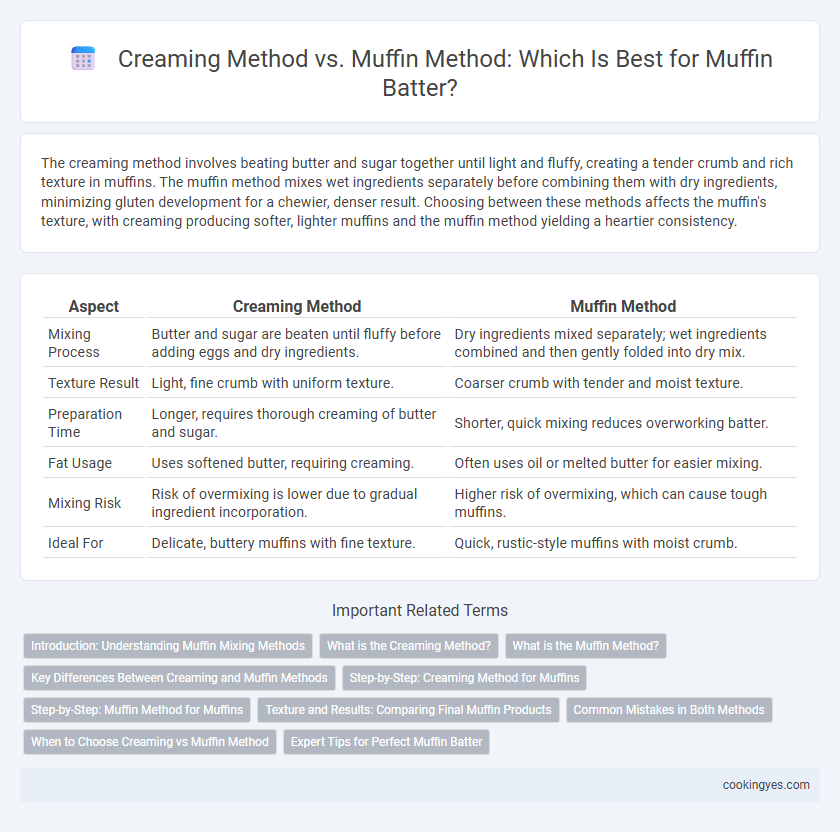The creaming method involves beating butter and sugar together until light and fluffy, creating a tender crumb and rich texture in muffins. The muffin method mixes wet ingredients separately before combining them with dry ingredients, minimizing gluten development for a chewier, denser result. Choosing between these methods affects the muffin's texture, with creaming producing softer, lighter muffins and the muffin method yielding a heartier consistency.
Table of Comparison
| Aspect | Creaming Method | Muffin Method |
|---|---|---|
| Mixing Process | Butter and sugar are beaten until fluffy before adding eggs and dry ingredients. | Dry ingredients mixed separately; wet ingredients combined and then gently folded into dry mix. |
| Texture Result | Light, fine crumb with uniform texture. | Coarser crumb with tender and moist texture. |
| Preparation Time | Longer, requires thorough creaming of butter and sugar. | Shorter, quick mixing reduces overworking batter. |
| Fat Usage | Uses softened butter, requiring creaming. | Often uses oil or melted butter for easier mixing. |
| Mixing Risk | Risk of overmixing is lower due to gradual ingredient incorporation. | Higher risk of overmixing, which can cause tough muffins. |
| Ideal For | Delicate, buttery muffins with fine texture. | Quick, rustic-style muffins with moist crumb. |
Introduction: Understanding Muffin Mixing Methods
The creaming method involves beating butter and sugar until light and fluffy, creating a denser, cakey muffin texture. The muffin method combines wet and dry ingredients separately before gently mixing, resulting in a tender, moist crumb with minimal gluten development. Each technique influences batter structure and final muffin quality, essential for achieving desired texture and taste.
What is the Creaming Method?
The creaming method involves beating softened butter with sugar until a light, fluffy texture forms, incorporating air that helps create a tender muffin crumb. This technique ensures even distribution of fat and sugar, producing a richer flavor and finer crumb structure compared to the muffin method. Proper creaming supports optimum leavening and moisture retention, resulting in moist, airy muffins with a delicate texture.
What is the Muffin Method?
The Muffin Method involves mixing dry ingredients separately from wet ingredients before combining them to create a lumpy batter, which is crucial for maintaining a tender crumb in muffins. Unlike the Creaming Method that relies on beating butter and sugar to incorporate air, the Muffin Method requires gently folding wet and dry components to avoid overmixing and developing gluten. This technique results in a moist, tender muffin texture with minimal gluten formation, ideal for quick breads and muffins where lightness and softness are desired.
Key Differences Between Creaming and Muffin Methods
The creaming method involves beating butter and sugar until light and fluffy, incorporating air for a tender crumb, while the muffin method mixes wet and dry ingredients separately before combining them minimally to avoid gluten overdevelopment. Creaming produces denser, finer-textured muffins with uniform crumb, whereas the muffin method yields lighter, more crumbly muffins with a coarser texture. Key differences lie in mixing technique, ingredient consistency, and resulting texture, impacting muffin moisture and rise.
Step-by-Step: Creaming Method for Muffins
The creaming method for muffin batter begins by beating softened butter and sugar together until the mixture becomes light and fluffy, incorporating air essential for a tender crumb. Gradually, eggs are added to fully emulsify the batter, followed by alternating additions of dry ingredients and liquids to maintain structure without overmixing. This technique ensures even distribution of ingredients and a fine, uniform texture in the finished muffins.
Step-by-Step: Muffin Method for Muffins
The muffin method begins by combining dry ingredients separately before mixing wet ingredients such as eggs, milk, and melted butter or oil in another bowl. Wet ingredients are poured into the dry ingredients and gently stirred just until moistened, ensuring a lumpy batter to prevent overmixing and maintain muffin tenderness. This technique results in a tender crumb and a well-risen muffin with a slightly uneven texture ideal for quick breads.
Texture and Results: Comparing Final Muffin Products
The creaming method produces muffins with a finer crumb and a lighter, cake-like texture due to the thorough incorporation of air when butter and sugar are beaten together. The muffin method yields a coarser, denser crumb with a slightly uneven texture, as wet and dry ingredients are mixed minimally to avoid gluten overdevelopment. Muffins made using the creaming method typically have a tender and uniform rise, while those from the muffin method often feature a more rustic, dome-shaped top with an irregular crumb structure.
Common Mistakes in Both Methods
Common mistakes in the creaming method include overmixing the batter, which develops gluten and results in dense, tough muffins, while undercreaming can lead to uneven texture and poor rise. In the muffin method, a frequent error is overmixing once wet and dry ingredients are combined, causing tunnels and a heavy crumb, whereas undermixing leaves lumps and uneven distribution of ingredients. Both methods require careful mixing to achieve tender, moist muffins with a consistent crumb structure.
When to Choose Creaming vs Muffin Method
Choose the creaming method for muffin batter when a tender, cake-like crumb with fine texture and buttery flavor is desired, as it incorporates air by beating butter and sugar. Opt for the muffin method when quick preparation and a denser, coarser crumb are preferred, mixing wet and dry ingredients with minimal stirring to avoid gluten overdevelopment. The creaming method suits recipes requiring volume and lightness, while the muffin method is ideal for straightforward, moist muffins with a slightly chewy texture.
Expert Tips for Perfect Muffin Batter
The creaming method incorporates softened butter and sugar to create a light, aerated batter, ideal for tender, cake-like muffins with even crumb structure. The muffin method blends melted butter or oil directly with wet ingredients, minimizing mixing to prevent gluten over-development and yielding a denser, moist texture. Experts recommend gentle folding and limiting mixing speed to maintain optimal batter consistency and achieve perfectly risen muffins every time.
Creaming method vs Muffin method for muffin batter Infographic

 cookingyes.com
cookingyes.com